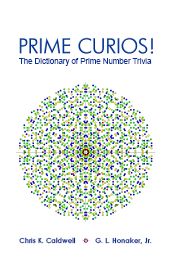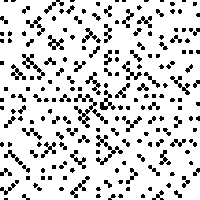Prime CuriosThe Dictionary of Prime Number Triviaby Chris K. Caldwell, G. L. Honaker Jr. |

|
This is a dictionary of prime number trivia, an eclectic collage of miscellaneous facts. A few of these tidbits have deep mathematical significance, but many are simple observations which require no mathematics.
For example, in what year did England make it illegal to jail a jury for returning the "wrong" decision? What was Jenny's phone number in Tommy Tutone's hit song? What is the highest number of votes a candidate received for the U.S. Presidency while incarcerated? The answers are all prime, and in this book.
Other results are quasi-mathematical, such as those having to do with the shape or representation of a number. Consider the prime 18181: This number is the same forwards, backwards, and even upside down--do you know how many of these primes there are? Can a prime be small and even, and at the same time, large and odd?
The heart of our book is the 235-page dictionary of 2151 curios about 1095 different primes recorded dictionary style as brief entries, with over 150 tables and figures. In addition, the book includes a chapter on the $100,000 prime and a prime Moore's law. We include a glossary of key terms and lists of small primes.
For one author, primes are an area of research, for the other, a passion; but both of us love recreational mathematics. There are quite a few books of number trivia, but none focused on just the primes. There are also many excellent books and websites addressing the theory of primes, but this one is just for the pleasure of it.

It is that joy, that pleasure, that is the heart and soul of the science of numbers: number theory. Yet out of idle ideas often comes real mathematics. For example, Stanislaw Ulam, while sitting bored in a meeting, started writing the numbers in an array, beginning with one and then "spiraling." When he marked the primes, there seemed to be lines of primes (click on the small image to see a larger one). These lines represent consecutive values of quadratic functions. Ulam's doodled spiral appeared on the cover of Scientific American the following year (March 1964), and still regularly generates research papers.
About the authors
Chris K. Caldwell is a professor of mathematics and statistics at the University of Tennessee at Martin. He earned his PhD in Mathematics at the University of California at Berkeley and did his undergraduate work at California State University East Bay. His areas of research include prime number theory and the use of computers (especially the World Wide Web) to teach mathematics.
G. L. Honaker, Jr. lives in Bristol, Virginia. A graduate of Virginia Intermont College, he has taught mathematics and science at a juvenile detention center for over 17 years. His enthusiasm for prime numbers is the driving force behind the online collection: "Prime Curios!" He also enjoys chess and teaching the solution to Rubik's Cube to those of all ages.
Prime Curios. The Dictionary of Prime Number Trivia, by Chris K. Caldwell, G. L. Honaker Jr. CreateSpace, 2009. Softcover, 316 pp, $17.00. ISBN 1448651700.
|Up| |Contact| |Front page| |Contents|
Copyright © 1996-2018 Alexander Bogomolny71752651
